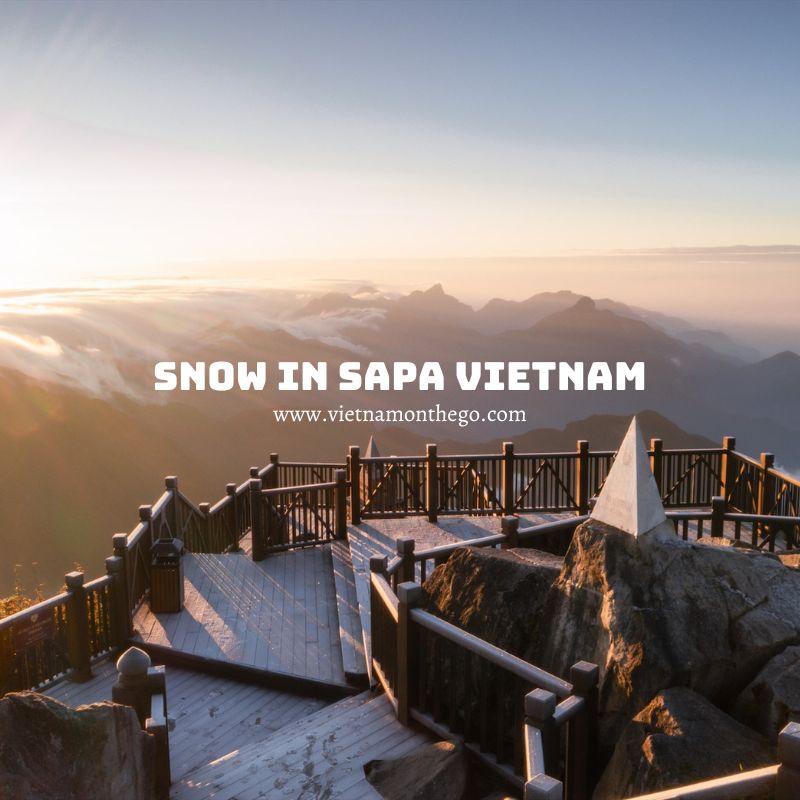Travel Guide, Sapa
Snow in Sapa Vietnam: Chasing Snow in the Northern Highlands Vietnam
Snow in Sapa Vietnam is a magical phenomenon that adds a special charm to the region’s breathtaking scenery. The breathtaking splendor of this wintry paradise is truly unforgettable for those who are fortunate enough to see it. Many travelers to Vietnam who choose Sapa as their destination are drawn to this feature.
In Sapa, Vietnam, when does it snow?
When does it snow in Sapa Vietnam? December weather in Sapa varies and shares different temperatures throughout the region, ranging from sunny days to snowy days and extremely cold temperatures. This region of Vietnam experiences somewhat different climates depending on where you are in the valley. Some regions experience relatively mild winters. Others can also experience the snow and cold – some places have recorded lows of -10°C. The temperature in Sapa, North Vietnam is influenced by a four-season cycle, which is comparable to the cycles found in Western Europe and North America, but the South of Vietnam experiences two distinct tropical seasons, known as the wet and dry seasons

Because Vietnam benefits from a tropical climate, any snow in Vietnam or the Sapa region is beneficial to the country. For farmers, the weather in Vietnam is a disaster. It is possible to ruin their crops. However, snow in Sapa Vietnam is a unique and breathtaking sight for Vietnamese tourists to witness. The sight of the snow is both astounding and surreal. This is an entirely different type of photo op. In general, this is a great time to travel to Vietnam.
You have the opportunity to witness a unique moment of beauty in Sapa while also experiencing the dry season in the south. Between the middle of December and the beginning of January, snow and snowfalls usually occur. They typically endure one or two days. You’ll need to be aware of the best locations for snowfall.
Which areas have the most Snow in Sapa Vietnam?
Since snowfall isn’t guaranteed everywhere in Sapa, you’ll need to know which are the snowiest locations to get the best views. As per the feedback from seasoned travelers, the locations with the most snowfall in Sapa are usually Hoang Lien Son Mountain, O Quy Ho Pass, Heaven Gate, Silver Fall, and Bat Xat Commune. Given that the closest location is 20 kilometers away and the farthest is 40 kilometers away, finding your way to these locations from Sapa Town’s center should be simple.

Ham Rong Mountain
The view of Sapa town can be obtained from Ham Rong Mountain, which is only 3 km away from the town itself. This location, which is 1800 meters above sea level, lets you explore the natural beauty of the area.
It provides breathtaking views of the layers of vegetation and is a light trekking destination. And the answer to the question of whether it snows in Vietnam is yes – winter in Sapa. Even the serene and dreamy Silver Waterfall meanders across the hillsides while one is standing in the Ham Rong mountain area, adding to the area’s natural beauty.
Fansipan Mountain
For travelers hoping to take in the stunning natural surroundings and distinctive cultural aspects of Fansipan, this is a must-visit location. You have two options for getting to the top: taking the easy route via cable car or starting a strenuous two-day climb.
Before you hit the roof of Indochina, there are breathtaking temples to explore at the summit. You can reach the highest point in Vietnam and, with any luck, see snow in Sapa, Vietnam, by climbing 600 more steps. The high humidity and low air pressure provide ideal snow-making conditions, giving the impression that one is in Europe. You can even make snowmen on really snowy days!
Bat Xat Commune

A beautiful place to look for clouds, Bat Xat commune in Sapa, Vietnam, allows visitors to see a lot of snowfall during the winter. Although the snow covers the fields and produces a picture-perfect winter scene, it also harms the crops and has an impact on the residents. The people of Bat Xat nevertheless provide visitors with fascinating and striking pictures of their everyday lives.
Experience this unique highland commune and take in the beauty of snow in Sapa Vietnam with a tour of Sapa Vietnam.
O Quy Ho Pass
One of the four major peaks in the Northwest, O Quy Ho Pass, has amazing views of Sapa from its summit. Wintertime brings lucky visitors the chance to see gorgeous snow-covered houses and trees. Silver Waterfall and Muong Hoa Valley are just two of the numerous other snow-covered locations in Sapa that are worth visiting.
Practical advice for your trip to to witness snow
The temperature can drop to -10 degrees Celsius when it snows. Here are a few helpful suggestions for your trip to see snow in Sapa Vietnam:
Transportation
Traveling to Sapa can take five to eight hours, depending on the mode of transportation chosen. These options include motorbikes, buses, and trains.
Motorbike: Riding a motorcycle is a popular way to travel for people who want the flexibility to pause and take in the scenery, but it’s important to take the weather into account. Because “sapa snow” can produce hazardous driving conditions, travelers should pack protective gear and warm clothing.
Train or car: Taking the car or train is another safe option. Numerous bus companies operate the Hanoi-Sapa route; however, during peak travel season, reservations are advised.
Clothes and accessories

Make sure you have enough appropriate clothing and the essential accessories ready, like a jacket, fur shoes, a scarf, a wool hat, gloves, and so forth. When it comes to clothing, you want to get the most practical items that will not only keep you dry and warm in the event of heavy fog or snowfall but also make moving around easier.
Extra notes
To maintain your health during your Vietnam tours in Sapa, you must pack a few basic personal necessities. More importantly, you need to carry certain medications with you to treat common illnesses, like the cold. To stay warm, you should also pack a bottle of wine and use it when the weather gets too chilly. Additionally, having a raincoat will make it easier for you to combat the wind and snow.
Unquestionably, snow in Sapa Vietnam, is incredibly alluring, and seeing it for yourself is a once-in-a-lifetime experience. Sapa’s snow-covered landscapes provide the ideal getaway, whether you’re an adventure seeker or just want to get away from the bustle of the city. It’s still a great time to visit Sapa, even if there isn’t any snow. This region of Vietnam offers some amazing scenery due to the weather and climate. The weather allows for some pleasant days of hiking. It’s possible that you won’t see any Sapa snow. These travel experiences will be cherished for a long time. Don’t hesitate any longer pack your bags and go to Sapa right away with the appropriate preparation and knowledge!
FAQs
Does Santa Claus come to Sapa?
While Santa Claus is not a traditional figure in Vietnamese culture, the celebration of Christmas has become more widespread, especially in tourist destinations or areas with a significant expatriate community. Sapa, being a popular tourist destination in northern Vietnam, may see some Christmas celebrations.
Santa is busy this time of year, so chances are you won’t see him. That doesn’t imply, however, that you shouldn’t visit Sapa in December. Vietnam is a very special place at this time of year. There is a variety of visually stunning scenery that is both captivating and educational, including snow-covered mountains and white rice paddies. It’s not well known that Vietnam has much snow. Because of this, a trip to this part of northern Vietnam is extremely uncommon. You should give this wonderful Christmas present to the people you care about and love.
What is the best time to visit Sapa if I want to see snow?
If your goal is to experience snow in Sapa, visiting during the winter months, especially January or February, would increase your chances. However, it’s essential to be aware that snowfall is not guaranteed.
How much snowfall can I expect in Sapa?
The amount of snowfall in Sapa can vary. Sometimes it’s just a light dusting, while in other instances, there may be more substantial snow cover. The intensity and duration of snowfall can differ from year to year.


![[1 DAY] Trekking in Sapa Through Muong Hoa Valley - EASY Route](https://vietnamonthego.com/wp-content/uploads/2023/12/Trekking-in-Sapa-Through-Muong-Hoa-Valley-2-280x280.jpg)
![[1 DAY] Trekking in Sapa Through Highest Village](https://vietnamonthego.com/wp-content/uploads/2023/12/fansipan-hiking-tour-1-day-3-280x280.jpg)
![[1 DAY] Trekking In Sapa Through Muong Hoa Valley - HARD Route](https://vietnamonthego.com/wp-content/uploads/2023/12/Muong-Hoa-Valley-280x280.jpg)
![[2 DAYS 1 NIGHT] Sapa Trekking Tour with Local Guide](https://vietnamonthego.com/wp-content/uploads/2023/12/Sapa-Trekking-Tour-with-Local-Guide-9-280x280.jpg)
![[2 DAYS 1 NIGHT] Sapa Trekking with Homestay in Village - EASY Trekking](https://vietnamonthego.com/wp-content/uploads/2023/12/fansipan-hiking-tour-1-day-5-280x280.jpg)
![[1 DAY] Fansipan Hiking Tour From Sapa with Local Expert fansipan hiking 1 day tour](https://vietnamonthego.com/wp-content/uploads/2023/12/fansipan-hiking-tour-1-day-280x280.jpg)
![[2 DAYS 1 NIGHT] Fansipan Mountain Hiking From Sapa Fanispan hiking 2d1n tour](https://vietnamonthego.com/wp-content/uploads/2023/12/fansipan-hiking-tour-2-1-280x280.jpg)